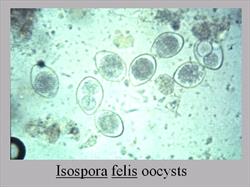(For veterinary information only)
WARNING
The size of the tablet/medication is NOT an indication of a proper dose. Never administer any drug without your veterinarian's input. Serious side effects or death can occur if you use drugs on your pet without your veterinarian's advice.
It is our policy not to give dosing information over the Internet.
Brand Names: Toltrazuril, Marquis, Ponalrestat
Available as 150 mg/gram oral paste for horses
Canine and feline formulas must be compounded
Background
Coccidia are single-celled organisms that attack intestinal cells causing potentially life-threatening diarrhea. Most mammals and birds can be infected, pets and livestock alike. There are even some species of coccidia that can be transmitted to humans.
Isospora felis oocysts

Photo courtesy Dr. Kirsten Vance
The traditional medications are called coccidiostats, meaning that they interfere with coccidian reproduction. Coccidia are not killed outright by these medications but stopping their reproduction buys time for the host's own immune system to respond and have fewer organisms to defeat. The host depends on a competent immune system to cure the infection and the time required to remove the infection is highly dependent on the number of organisms already present when treatment begins.
Ponazuril represents a new approach to treatment. Ponazuril actually kills the coccidia, which makes for a faster response to treatment and shorter course of therapy. The problem for dogs and cats is that ponazuril is manufactured for horses and comes in a paste that is impractical for small animal use. The paste can be diluted and used orally in dogs and cats for control of coccidia. It is common for animal shelters and other areas where coccidia are common to automatically treat puppies and kittens at intake.
How This Medication Is Used
For intestinal coccidia, the compounded formula is given orally for one to seven days. A three-day course seems to be the most common recommendation.
For toxoplasmosis or to treat infection with Neospora caninum (both conditions being special, more invasive coccidia infections), ponazuril should be given for approximately one month.
Side Effects
Horses sometimes get an upset stomach or a rash around the mouth where the medication is delivered. (In horses, ponazuril is often given for 28 days as their target parasite requires a longer course.) So far this medication has not been formally studied in small animals despite its wide use in shelter situations.
There have been reports of reduced ability to produce tears (keratoconjunctivitis sicca) in dogs, particularly in breeds that are predisposed to having tear function problems.
Concerns And Cautions
- If you have received a compounded version of ponazuril to give at home, store the product in the refrigerator prior to use.
- If you skip a dose, the course of treatment may not be effective. Do not double up on the next dose, however; simply pick up with the next dose as scheduled. If desired results are not achieved after protocol involving a missed dose, it is possible that the entire course may have to be repeated.
- Ponazuril has not been studied in pregnancy, even in horses.
It is our policy not to give dosing information over the Internet.